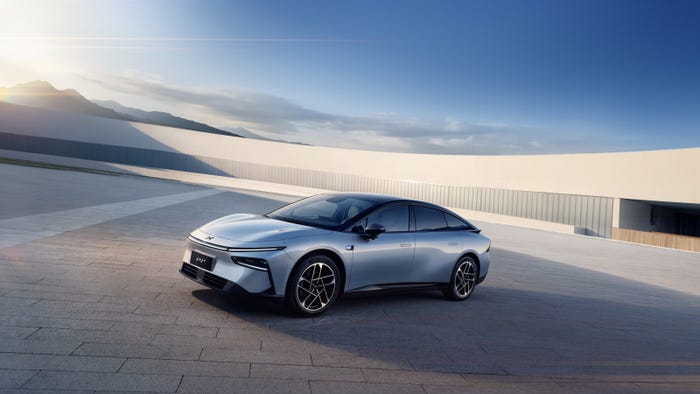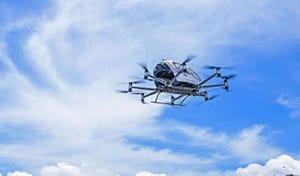Autonomous Vehicles: What Fleets Want
Most remain in wait-and-see mode where driverless trucks are concerned.
August 17, 2016

By Sean Kilcarr
While the public and the trucking industry continue to debate the viability of autonomous vehicles (AVs), fleet executives are clearly anticipating their arrival. A recent survey conducted by the Technology & Maintenance Council (TMC) and the American Transportation Research Institute (ATRI) of 32 executives representing 31 fleets found that the majority expect AVs to become reality at some future point. It’s clearly a question of when, not if, says Paul Menig, CEO of consulting firm Tech-I-M and one of the study’s principal authors.
And the reason is likely because many of the technologies being used in the autonomous test vehicles developed to date by Daimler, Peterbilt and others are real-world technologies being deployed every day in fleets today. Wallace Lau, an analyst with the automotive and transportation practice at global consulting firm Frost & Sullivan, notes that common technologies that have proven their worth include electronic stability control (ESC), collision avoidance technology, rear- and forward-view camera systems plus related electronic sensor arrays required to transmit data between such systems and a truck’s engine, transmission, and brakes.
“In fact, we��’re already seeing the use of true AVs in the agricultural, defense and mining industries today,” he notes. “The key question is how OEMs will package and sell AVs as a benefit to [trucking] fleets.”
So, how will OEMs sell fleets on the benefits? Well, it’s important to know what fleets want out of autonomous vehicles—and that is the more difficult question to answer.
Lau says that he hasn’t spoken to any fleets actively looking to adopt driverless truck technologies anytime soon. That’s a fact that would seem to be backed by Fleet Owner’s own experiences. When contacted by Fleet Owner for this article, major fleets all declined to be interviewed citing uncertainties with issues such as price tags and necessary regulatory changes required to legally operate such vehicles on U.S. roadways.
The real barriers to AV adoption from a fleet perspective are how they deal with bad weather such as ice and heavy rain and the resulting road conditions as well as other major events.
“However, completely driverless vehicles—ones that are hands off the wheel as well as foot off the accelerator and brake—are not really what they are talking about here,” Menig explains. Rather, there is more of a focus on “semi-autonomous” truck capability, perhaps for short durations on the highway but more applicable in low speed environments such as at truck stops or at warehouse docks, he says.
“The thought here is, why should a driver have to stay on duty while fueling up his or her truck or moving a trailer to a particular loading dock? Why not let the truck perform that task and allow the driver to go off duty for 30 minutes or an hour,” Menig notes. “That is the potential, but it is still not all that easy to do.”
AV pricing
Frost & Sullivan’s research indicates the incremental cost of AV systems right now is around $30,000 compared to a standard truck operated by a human driver, a cost that covers sensors, telematics upgrades, human-to-machine interface connections, driveline enhancements, and software algorithms.
While the company predicts early-stage autonomous commercial vehicles will see active use on North American roadways by 2025—largely in platooning operation—the total incremental cost for driverless systems won’t decline by more than 10%. This is due to information technology (IT) needs centered around cybersecurity and safety, Lau says.
“Any vulnerable electronic interface will need to be secured, especially as [AV] systems are going to be extremely complex,” he notes. “There will also need to be multiple redundancies in case primary [control] systems fail or if there’s a cyberattack on them.”
As a result, Frost & Sullivan doesn’t expect to see fully autonomous trucks deployed on U.S. roadways for at least another two decades. From a global perspective, the firm predicts an estimated 7,970 autonomous-enabled trucks will be sold worldwide by 2025 for on-road applications, rising to 182,031 units by 2035.
Neil Cawse, CEO of IT firm Geotab, stresses that hacking concerns relative to driverless trucks need to be put into perspective.
“Data and IT system security will be huge issues in the next 10 years, not just for trucking but for all businesses,” he explains. “But understand that no system is absolutely secure; the real question is whether a system is more or less secure. If you have enough money and state sponsorship, any system can be hacked.”
Cawse notes, however, that the science-fiction scenario of hundreds of trucks being instantly hacked and controlled via a remote computer for diabolical purposes is in reality “incredibly difficult” to achieve.
“It would require a year’s worth of time and a lot of money to hack into a vehicle over the air, so it’s almost cost-prohibitive,” he emphasizes. “Now, if you can plug a device into the vehicle’s onboard diagnostic port, that’s a very different situation. But I don’t call that a hack because those ports are designed for easy access.”
The biggest risk posed by AVs, Cawse says, is the amount of machine learning needed to equal what he calls the human perspective.
Prior experience
“Human beings are fallible; we make mistakes and run off the road when we can’t see the road clearly,” he points out. “Well, machines face some of those very same issues. They need to be able to calculate where the edge of the road is. If the lines on the roadway are not clear or if they are obscured by rain, they will run the truck off the road as well. The biggest worry is not from hacking but whether the machine controlling the truck will always be able to see the road.”
A few fleet operators, though, believe long-term experiences with autonomously guided vehicles (AGVs) in manufacturing plants around the world provide a concrete pool of knowledge that can be tapped in developing driverless trucks.
“Some warehouse operations have been using self-driving vehicles to some extent for years,” notes Markus Kückelhaus, vice president of innovation and trend research at DHL Customer Solutions & Innovation. “Moving onto public roads is the next evolutionary step. With its history in deploying self-driving solutions in controlled environments, the logistics industry is in a prime position to further shape the future of self-driving vehicles.”
He delved into this subject in a 40-page report entitled “Self-Driving Vehicles in Logistics.” Long-term experiences with AGV technology, Kückelhaus believes, will translate directly into safely moving goods driverlessly in over-the-road applications.
Other uses
“A first step in this direction is taking place in ports and freight yards across the globe, specifically to maneuver and reposition containers and pallets in what are often highly congested areas,” Kückelhaus says, “thereby removing humans from danger’s path.”
He specifically points out that container handling at the Container Terminal Altenwerder in Hamburg, Germany, is almost completely automated, thanks to a fleet of 84 battery-powered driverless vehicles. Those vehicles transport freight containers between the wharf and the storage areas, he explains. Navigation is performed by tapping into a network of 19,000 transponders that are installed in the ground.
“This greatly increases the speed and efficiency of container handling in comparison to traditional transport methods using trucks and cranes and highlights the key elements and significant potential of autonomous technologies in the logistics industry,” Kückelhaus says.
He believes such self-driving systems could be deployed at airports to transport cargo-carrying unit load devices (ULDs) to and from airport terminal gates and planes. The next step might be the automated handover to a self-driving ULD transporter that automatically loads and unloads each plane, Kückelhaus adds.
There’s also an energy-saving component to such self-driving vehicles.The aim of the Altenwerder container transport effort is to charge the batteries of its AGVs during off-peak hours when the electrical grid in northern Germany has a surplus of energy.
Kückelhaus notes another interesting possibility where such self-driving freight vehicles are concerned is the concept of a self-driving “Packstation” to handle last-mile deliveries to customers.
“Today, the customer must go to a central repository to retrieve their shipments, [but] a Packstation could autonomously come closer to them,” he explains. “[Like] a municipal library bus, it could stop at designated locations at certain times and open its doors to the public . . . all without a driver. Such self-driving repositories could become a model for mobile delivery [of shipments] in the future.”
The payoff
Making AV technology pay off for fleets, though, remains the real challenge. Sandeep Kar, global vice president of automotive and transportation at Frost & Sullivan, says that three total cost of ownership (TCO) benefits will be critical to making driverless trucks an attractive investment for fleets over time.
“It starts with driver satisfaction for both existing and future truck operators,” he explains. “Drivers won’t have to physically operate the truck for long periods as the technology will allow them to take breaks and stay connected with the world outside while in the cab. That connectivity will be very important for recruiting younger drivers.”
Increased fuel efficiency, lower maintenance costs from more optimized truck operation, and improved safety performance are some of the benefits fleets should see because of autonomous vehicle guidance systems, Kar adds.
Autonomous technology could help alleviate the driver shortage in long-haul operation and offer an alternate to wage hikes as it would provide drivers with a less stressful and safer work environment, he says.
“Take truck platooning, which is really the first step in the AV process,” Kar points out. “Drivers could take two-hour turns driving at the head of a platoon then switch with another driver. It allows them to disengage with driving for set periods, and that would probably help attract more entrants to the profession. That’s why we see a possible solid [return on investment] for this technology.”
One military veteran now involved in the industry also sees other roles semi-autonomous systems can play in the commercial truck world based in part on his combat experience.
“The U.S. military has been experimenting with self-driving trucks for a while . . . that technology could have been especially useful when I was on convoy duty in Iraq—with one hand on the steering wheel and one on my M-16 rifle,” says Rob Ahlers, president and CEO of MSR Transport Services and also a captain in the U.S. Army Reserves.
In the civilian world, he believes giving a driver the ability to cede partial or full control over to a semi-autonomous truck can improve situational awareness, especially when hauling high-value goods, such as pharmaceuticals.
“We’re not talking about reading a book behind the wheel; we’re talking about a driver being able to put their full attention on a possible threat, such as cargo theft,” says Ahlers, a CDL holder with long years of both civilian and military motor vehicle operation under his belt.
Best uses
“When you are out West on long stretches of empty highway, [semi-autonomous systems] could be useful for allowing a driver to complete paperwork or for owner-operators to search and lock in available loads before reaching their destination,” he explains.
Ahlers also thinks we won’t see fully driverless trucks operating on U.S. roadways anytime soon simply due to the country’s huge diversity of fleet operations.
“I work in the expedited world; we’re picking up freight 90 minutes after the phone call comes in,” he explains. “I just don’t think you could safely plan and lock in a route for a driverless truck in such a compressed time window.”
Yet Tech-I-M’s Menig says that diversity means some industry segments can draw benefits from semi-autonomous and even fully autonomous trucks more than others.
“[Hazardous material] loads, for instance, are required to move during the day,” he says. “Yet the least amount of highway traffic occurs at night between 6 p.m. and midnight. Indeed, one of the things that surprised me [about the TMC/ATRI study results] is how many fleets operate between 6 p.m. and 6 a.m. and how perhaps these systems could help move more of it [freight] during those less-congested times.”
While trucking and freight shipments run on a 24/7 clock, everyday motorists do not. “So encouraging ways to safely transfer more freight to off-peak highway hours might be one role AVs could perform in the future,” he says.
And it’s because of such safety benefits that many current and former regulators are pushing hard to make AVs a reality.
“Obviously, we have to perfect all of the safety technology involved first before we take the next step and put [AVs] on the road,” noted Mark Rosenker, former chairman of the National Transportation Safety Board (NTSB), during a presentation at the 2015 ALK Transportation Technology Summit. “There can be no glitches; it must be reliable, just like autopilot in aviation,” he said.
The current capability and reliability of commercial jetliner autopilot technology is why Rosenker thinks AV doubters should consider such technology.
“Once that jumbo jet carrying hundreds of people reaches 1,000 ft. after takeoff, the autopilot takes over; in fact, you don’t want the crew touching the controls at all in ‘coffin corner,’” he explains. Coffin corner refers to the difficulty of keeping an airplane in stable flight at high altitudes. “Indeed, a change of just three degrees up or down can cause the plane to stall,” Rosenker says.
That’s why autopilot is vital at high altitudes. For instance, Rosenker notes that there’ve been no fatal accidents among “number 121 operators”—the NTSB moniker given to U.S. commercial airlines such as United and Delta—in about six years. The airlines have safely carried 4 billion passengers over the course of 70 million flights (roughly 30,000 commercial flights per day or 10.9 million per year) to their final destinations with nary a problem.
“This is the safest era of aviation ever,” Rosenker points out, and autopilot is one reason that’s so. It’s gotten so good that the autopilot systems on Boeing’s 777 jetliner are rated “Category III,” meaning autopilot can land them. The 777 has an empty weight of 297,300 lbs. and can carry up to 451 people and travel at speeds up to 590 mph.
Rosenker stresses that this doesn’t mean AVs are going to start popping up all over U.S. highways anytime soon, because one of the reasons jetliner autopilot technology is so good is that it’s been put through the engineering wringer for decades. Thus, he thinks a similar period of engineering work still remains to be completed before AVs start hitting the road in significant numbers.
“This is going to be an evolutionary process,” he emphasizes. “It won’t be tomorrow; it won’t be five years from now. I’m suggesting 15 to 20 years. [AVs] will also be confined to certain lanes. But they will be of great value on our highways.”
AVs: What do motorists think?
When it comes to deploying completely autonomous vehicles (AVs) on our roadways, most everyday motorists—like trucking fleets—are more skeptical than enthusiastic, at least according to several surveys on the topic.
Global consulting company Arthur D. Little conducted a worldwide survey of 65,000 consumers in 10 countries and found only a third would be willing to use an autonomous vehicle. The firm’s “Global Automotive Mobility Study” discerned that consumers are “very skeptical” about autonomous driving, especially in major markets. Just 29% of respondents in the U.S. intend to use an autonomous car, 30% harbor doubts about the technology, 37% worry about the safety of AVs, and 40% will not consider using AVs at all.
On the plus side, though, the poll found that traffic jams provide the most attractive use case for fully autonomous or partly autonomous vehicles, followed by highway driving.
A different survey put together by the College of Engineering at Carnegie Mellon University found that improvements to driver safety may be the key to broader acceptance of self-driving vehicles. To figure out the consumer perspective regarding self-driving cars, the college polled 1,000 people in the United States between the ages of 18 and 70.
By extension, the school stressed to its survey participants that such vehicles would also automatically move at safe speeds, keep a safe distance from surrounding cars, change traffic lanes, obey traffic signals, and follow GPS directions to destinations.
From that perspective, Carnegie Mellon’s poll determined that there are 10 situations motorists believe will be made less hazardous with self-driving cars. In order they are:
Night driving
Unfamiliar areas and roads
Congested roads
Bad snowstorms
Merging traffic situations
Interstate travel
City taxi
Daytime driving
School bus
Running errands
With safety in mind, respondents also said they wanted additional features in AVs, including driver fatigue warnings (57%) and parental controls to set speed limit, curfew time and number of passengers in the car (83%).
Yet price, as always, is a stumbling block. A majority of respondents (70%) said they wouldn’t buy a car with self-driving capability if it cost 30% more than a comparable car without it.
Drilling down in the data, the school found that millennials were the most willing to pay a premium price, indicating that they may be early adopters of these vehicles.
Interestingly, men (29%) and women (28%) were almost equal in their willingness to spend more for an autonomous car.
This article originally appeared on our sister site Fleet Owner.
You May Also Like





.jpg?width=300&auto=webp&quality=80&disable=upscale)
